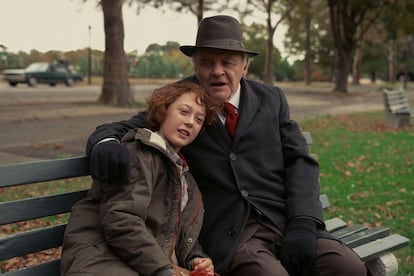A boy from Queens and a Polish donkey move audiences at Cannes
The American James Gray evokes the end of childhood in ‘Armageddon Time’ and veteran Jerzy Skolimowski shows the animal tale ‘EO’


At what point in life, and at what price, do humans lose their innocence? Do donkeys, for instance, also lose it? On Thursday, the official selection of the Cannes festival gave a moving answer to these questions. American director James Gray, one of the brightest of his generation and a darling of this competition, brought his film Armageddon Time to La Croisette. The semi-autobiographical film evokes the moment in which a boy from Queens leaves his neighborhood school for a private one attended by the New York elite. The film is set in the 1980s, at the dawn of the savage neoliberalism that marked the Reagan era.
It revolves around the protagonist’s family, played by a prodigious cast in which Anne Hathaway, Anthony Hopkins and Jeremy Strong stand out, and around the boy’s friendship with an African-American classmate. Armageddon Time brings together many of the obsessions of the director of Ad Astra and The Lost City of Z, filtered through the gaze of a child whose furtive walks through New York recalls Salinger’s Holden Caufield. The talkative boy, out of his element and gazing critically at the imperfect world around him, dreams of being an artist and doing whatever he wants. Armageddon Time is sentimental in the best sense of the word, while still being uncynically rough and tough. It gives a nod to the Trump family in the classism and racism that it portrays, and it culminates with a boy becoming a man.
The innocent gaze of EO’s donkey will never know that transition to maturity. Veteran Polish filmmaker Jerzy Skolimowski’s EO is reminiscent of the immersion in animal life of recent films such as Cow, by Andrea Arnold, but it goes much further. The film pays tribute to Robert Bresson’s classic Au Hasard Balthazar, in the context of industrial farming, and it drew the first applause in the screening of specialized critics.
Skolimowski’s film is impressive. Separated from a circus and his doting owner, the film’s little donkey embarks on a journey of no return in which he faces the truth of a world hostile to animals. Skolimowski’s beautiful images take place against an apocalyptic backdrop, where animals are cast out of paradise into the fire. The film shows a world incapable of asking the right questions about animals, from the foxes farmed for their fur, the stable of thoroughbred horses or the circus that releases the donkey after an animal rights protest.

Skolimowski’s only error is the inclusion of an absurd episode starring the French actress Isabelle Huppert. Aside from that, his film confronts us with fundamental philosophical questions about animals’ consciousness and communication, their instincts about life and death and how animals, particularly horses, have also become captured by the image. Like Béla Tarr in The Turin Horse—a film inspired by the episode when Nietzsche tearfully embraced a beaten horse in the middle of the street—Skolimowski reminds us, through a donkey’s gaze, that when we steal animals’ innocence, we lose our own humanity.
Tu suscripción se está usando en otro dispositivo
¿Quieres añadir otro usuario a tu suscripción?
Si continúas leyendo en este dispositivo, no se podrá leer en el otro.
FlechaTu suscripción se está usando en otro dispositivo y solo puedes acceder a EL PAÍS desde un dispositivo a la vez.
Si quieres compartir tu cuenta, cambia tu suscripción a la modalidad Premium, así podrás añadir otro usuario. Cada uno accederá con su propia cuenta de email, lo que os permitirá personalizar vuestra experiencia en EL PAÍS.
¿Tienes una suscripción de empresa? Accede aquí para contratar más cuentas.
En el caso de no saber quién está usando tu cuenta, te recomendamos cambiar tu contraseña aquí.
Si decides continuar compartiendo tu cuenta, este mensaje se mostrará en tu dispositivo y en el de la otra persona que está usando tu cuenta de forma indefinida, afectando a tu experiencia de lectura. Puedes consultar aquí los términos y condiciones de la suscripción digital.
More information
Últimas noticias
Imelda Castro, the woman who wants to rule the cartel battleground of Sinaloa
The new victims of the Republican war on Obamacare: Millions hit by soaring health insurance premiums
A country divided on migrant rights: Some US states expand protections while others restrict them
Venezuela authorizes the release of another 87 political prisoners
Most viewed
- David King, chemist: ‘There are scientists studying how to cool the planet; nobody should stop these experiments from happening’
- Reinhard Genzel, Nobel laureate in physics: ‘One-minute videos will never give you the truth’
- Oona Chaplin: ‘I told James Cameron that I was living in a treehouse and starting a permaculture project with a friend’
- Sinaloa Cartel war is taking its toll on Los Chapitos
- The Interoceanic Train, the Mexican alternative to the Panama Canal










































